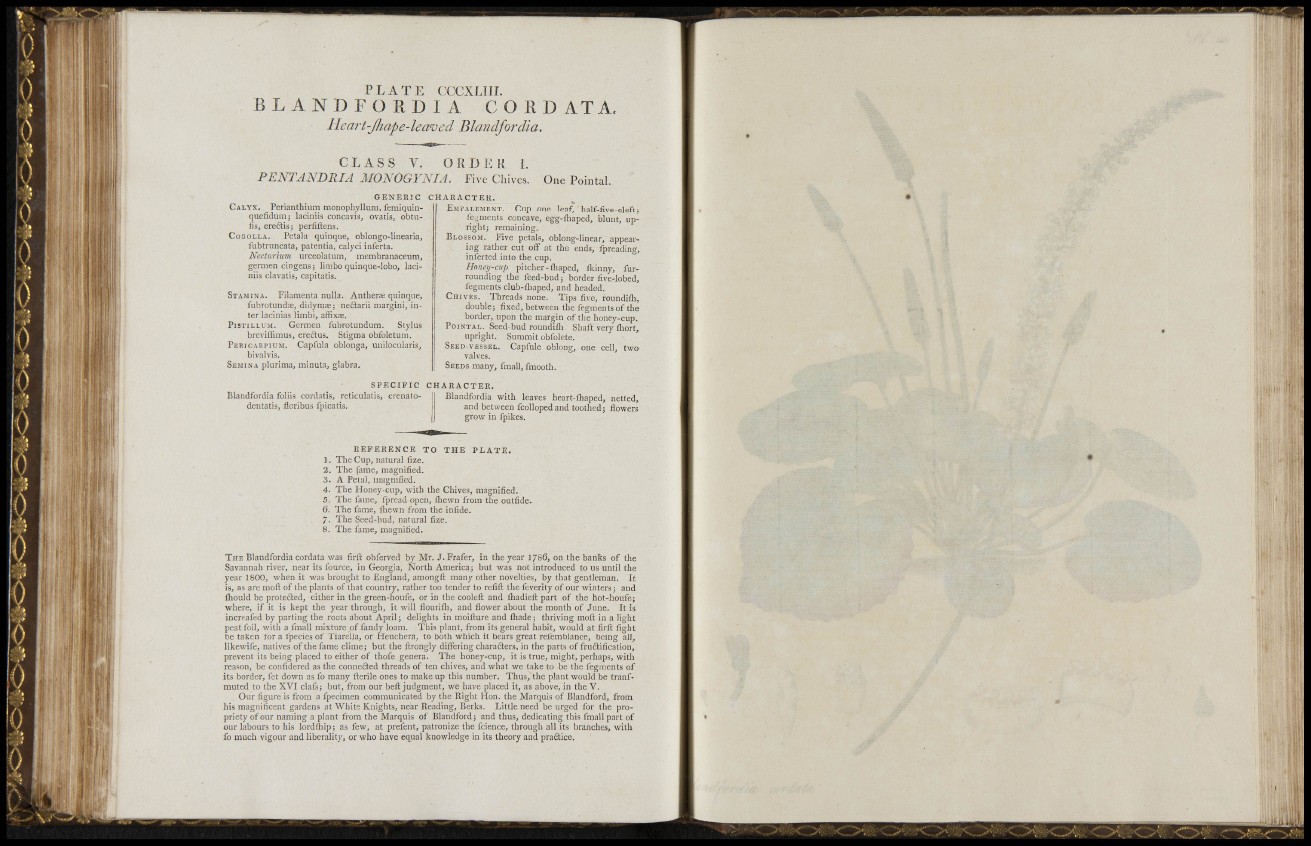
V ;ir
Is
•Í ^
j. jlj
J
i . ; ii i r ' i i p
B L
P L A T E CCCXLIII.
A N D F O R D I A C O R D ATA.
Heart-Jhape-learoed Blandfordia.
C L A S S V. ORDER I.
PENTANDRIA 3I0N0GYNIA. Five Chives. One Pointai.
GENERIC
CALYX. Perianthium monophyllum, femiquinquefiduni;
laciiiiis concavis, oyacis, obtuiis,
ereftis; perlillens.
CoiiOLLA. Pétala quinqué, oblongo-llneavia,
iubtrnncata, patentia, calyci infería.
Nectarium urceolatum, membranaceum,
germen cingens; limbo quinque-lobo, laciniis
clavatis, capitatis.
STAMINA. Filamenta nulla. Anthera; quinqué,
lubrotundae, didymas; neñarii margini, inter
lacinias limbi, affixse.
PISTILLUM. Germen fubrotundam. Stylus
breviflimus, ereftus. Stigma obfoletum.
PERICARPIUM. Capfula oblonga, unilocularis,
bivalvis.
SEMINA plurima, minuta, glabra.
SPECIFIC
Blandfordia foliis cordntis, reticulatis, crenatodentatis.
Acribas fpicatis.
CHARACTER.
EMPALEMENT. Cup one leaf, half-five-cleft;
feginenls concave, egg-fliaped, blunt, upright;
remaining.
BLOSSOM. Five petals, oblong-linear^ appearing
ratlier cut off at the ends, fpreading,
inferted into the cup.
Haney-cup pitcher-iliaped, Itinny, furrounding
the feed-bud ; border five-lobed,
fegments club-fliaped, and headed.
CHIVES. Threads none. Tips five, roundilli,
doable; fixed, between the fegments of the
border, upon the margin of the honey-cup.
POINTAL. Seed bud roundifli Shaft very fliort,
upright. Summit obfolete.
SEED-VESSEL. Capfule oblong, one cell, two
valves.
SEEDS many, fmall, fmooth.
CHARACTER.
Blandfordia with leaves heart-fliaped, netted,
and between fcollopedand toothed; flowers
grow in fpikes.
REFERENCE TO THE PLATE.
1. The Cup, natural fize.
2. The (arae, magnified.
3. A Petal, magnified.
4. The Honey-cup, with the Chives, magnified.
5. The fame, fpread open, fliewn from the outfide.
6. The fame, fliewn from the infide.
7. The Seed-bud, natural fize.
8. The fame, magnified.
THE Blandfordia cordata was firft obferved by Mr. J. Frafer, in the year 17S6, on the banks of the
Savannah river, near its fource, in Georgia, North America; but was not introduced to us until the
year 1600, when it was brought to England, amongfl: many other novelties, by that gentleman. It
is, as are moft of the plants of that country, rather too tender to refill the feverity of our winters; and
ihould be prote6led, either in the green-houfe, or in the coolefl: and lliadiefl: part of the hot-houfe;
where, if it is kept the year through, it will flourifh, and flower about the month of June. It is
increafed by parting the roots about April; delights in moifture and fliade; thriving moft in a light
peat foil, with a fmall mixture p f fandy loam. This plant, from its general habit, would at firft fight
be taken for a fpecies of Tiarella, or Heuchera, to both which it bears great refemblance, being all,
likewife, natives of the fame clime; but the ftrongly differing characters, in the parts of fruft ificat ion,
prevent its being placed to either of thofe genera. The honey-cup, it is true, might, perhaps, with
reason, be confidered as the connefled threads of ten chives, and what we take to be the fegments of
its border, fet down as fo many fterile ones to make up this number. Thus, the plant would be tranfmuted
to the XVI clafs; but, from our beft j u d gme n t , we have placed it, as above, in the V.
Our figure is f rom a fpecimen communicated by the Right Hon. the Marquis of Blandford, from
his magnificent gardens at Whi t e Knights, near Reading, Berks. Little need be urged for the propriety
of our naming a plant from the Marquis of Blandford; and thus, dedicating this fmall part of
our labours to his lordlliip; as few, at prefent, patronize the fcience, through all its branches, with
fo much vigour and liberality, or who have equal knowledge in its theory and prailice.